Eric Laloy
SCK-CEN
A new framework for experimental design using Bayesian Evidential Learning: the case of wellhead protection area
May 12, 2021



Abstract:In this contribution, we predict the wellhead protection area (WHPA, target), the shape and extent of which is influenced by the distribution of hydraulic conductivity (K), from a small number of tracing experiments (predictor). Our first objective is to make stochastic predictions of the WHPA within the Bayesian Evidential Learning (BEL) framework, which aims to find a direct relationship between predictor and target using machine learning. This relationship is learned from a small set of training models (400) sampled from the prior distribution of K. The associated 400 pairs of simulated predictors and targets are obtained through forward modelling. Newly collected field data can then be directly used to predict the approximate posterior distribution of the corresponding WHPA. The uncertainty range of the posterior WHPA distribution is affected by the number and position of data sources (injection wells). Our second objective is to extend BEL to identify the optimal design of data source locations that minimizes the posterior uncertainty of the WHPA. This can be done explicitly, without averaging or approximating because once trained, the BEL model allows the computation of the posterior uncertainty corresponding to any new input data. We use the Modified Hausdorff Distance and the Structural Similarity index metrics to estimate the posterior uncertainty range of the WHPA. Increasing the number of injection wells effectively reduces the derived posterior WHPA uncertainty. Our approach can also estimate which injection wells are more informative than others, as validated through a k-fold cross-validation procedure. Overall, the application of BEL to experimental design makes it possible to identify the data sources maximizing the information content of any measurement data.
Pixel-wise Conditioned Generative Adversarial Networks for Image Synthesis and Completion
Feb 04, 2020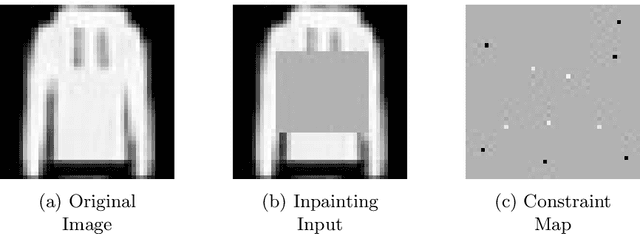
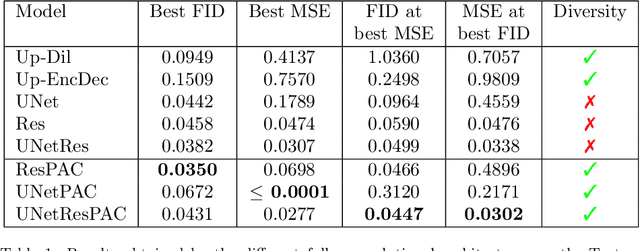
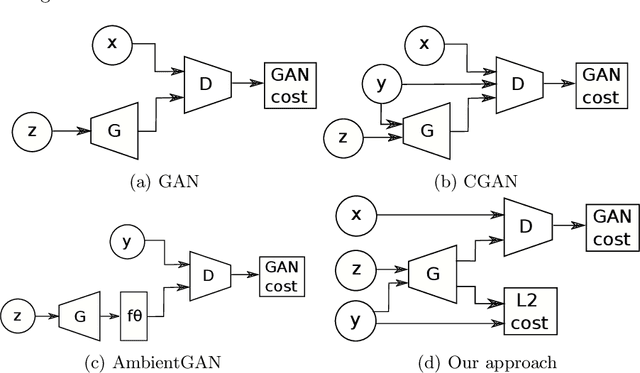

Abstract:Generative Adversarial Networks (GANs) have proven successful for unsupervised image generation. Several works have extended GANs to image inpainting by conditioning the generation with parts of the image to be reconstructed. Despite their success, these methods have limitations in settings where only a small subset of the image pixels is known beforehand. In this paper we investigate the effectiveness of conditioning GANs when very few pixel values are provided. We propose a modelling framework which results in adding an explicit cost term to the GAN objective function to enforce pixel-wise conditioning. We investigate the influence of this regularization term on the quality of the generated images and the fulfillment of the given pixel constraints. Using the recent PacGAN technique, we ensure that we keep diversity in the generated samples. Conducted experiments on FashionMNIST show that the regularization term effectively controls the trade-off between quality of the generated images and the conditioning. Experimental evaluation on the CIFAR-10 and CelebA datasets evidences that our method achieves accurate results both visually and quantitatively in term of Fr\'echet Inception Distance, while still enforcing the pixel conditioning. We also evaluate our method on a texture image generation task using fully-convolutional networks. As a final contribution, we apply the method to a classical geological simulation application.
Pixel-wise Conditioning of Generative Adversarial Networks
Nov 02, 2019
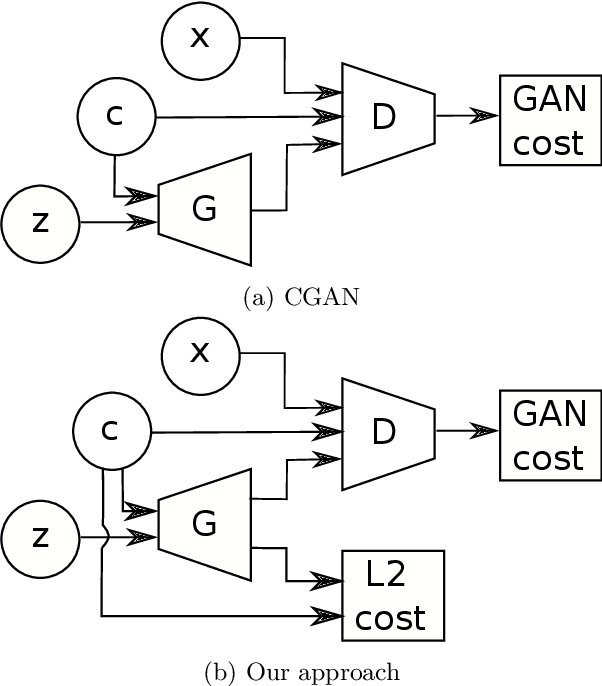

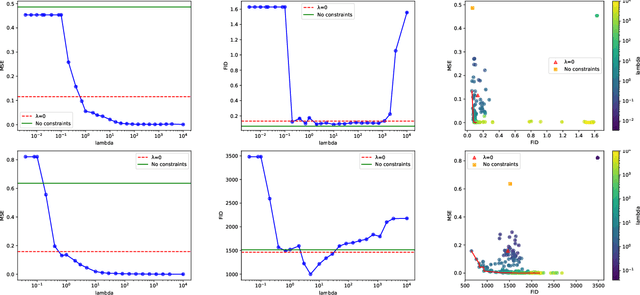
Abstract:Generative Adversarial Networks (GANs) have proven successful for unsupervised image generation. Several works extended GANs to image inpainting by conditioning the generation with parts of the image one wants to reconstruct. However, these methods have limitations in settings where only a small subset of the image pixels is known beforehand. In this paper, we study the effectiveness of conditioning GANs by adding an explicit regularization term to enforce pixel-wise conditions when very few pixel values are provided. In addition, we also investigate the influence of this regularization term on the quality of the generated images and the satisfaction of the conditions. Conducted experiments on MNIST and FashionMNIST show evidence that this regularization term allows for controlling the trade-off between quality of the generated images and constraint satisfaction.
Dilated Spatial Generative Adversarial Networks for Ergodic Image Generation
May 15, 2019



Abstract:Generative models have recently received renewed attention as a result of adversarial learning. Generative adversarial networks consist of samples generation model and a discrimination model able to distinguish between genuine and synthetic samples. In combination with convolutional (for the discriminator) and de-convolutional (for the generator) layers, they are particularly suitable for image generation, especially of natural scenes. However, the presence of fully connected layers adds global dependencies in the generated images. This may lead to high and global variations in the generated sample for small local variations in the input noise. In this work we propose to use architec-tures based on fully convolutional networks (including among others dilated layers), architectures specifically designed to generate globally ergodic images, that is images without global dependencies. Conducted experiments reveal that these architectures are well suited for generating natural textures such as geologic structures .
Inversion using a new low-dimensional representation of complex binary geological media based on a deep neural network
Oct 25, 2017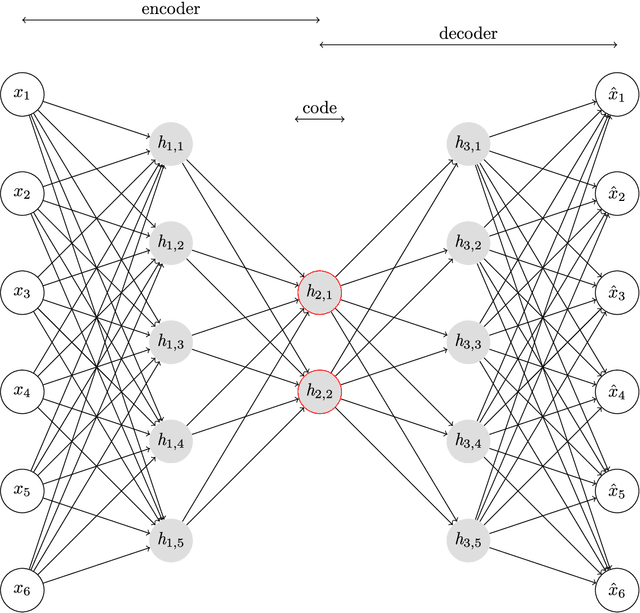
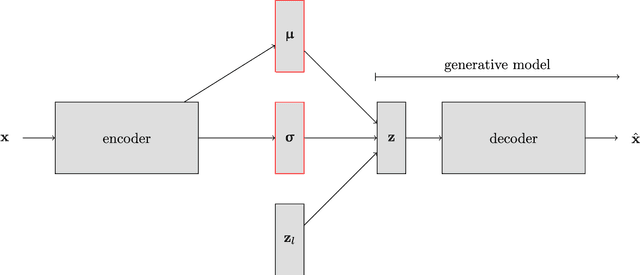
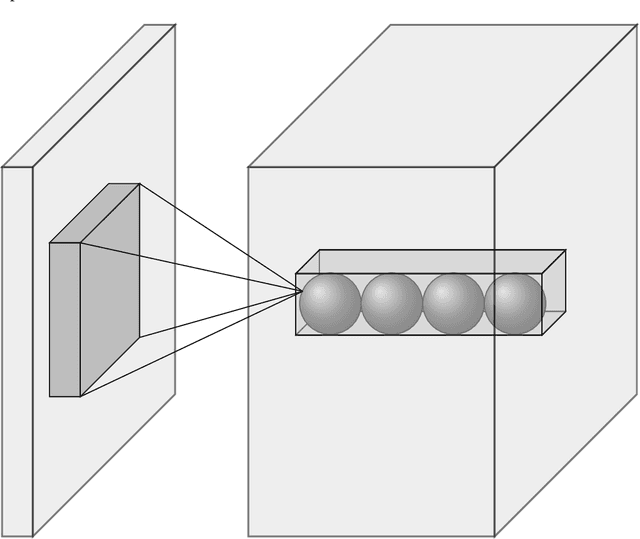
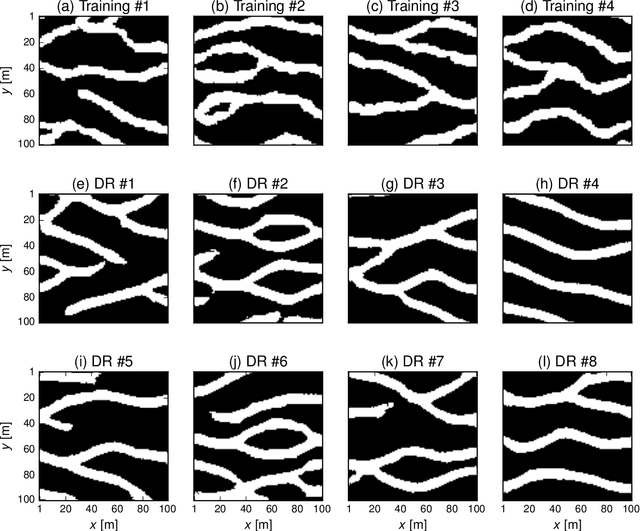
Abstract:Efficient and high-fidelity prior sampling and inversion for complex geological media is still a largely unsolved challenge. Here, we use a deep neural network of the variational autoencoder type to construct a parametric low-dimensional base model parameterization of complex binary geological media. For inversion purposes, it has the attractive feature that random draws from an uncorrelated standard normal distribution yield model realizations with spatial characteristics that are in agreement with the training set. In comparison with the most commonly used parametric representations in probabilistic inversion, we find that our dimensionality reduction (DR) approach outperforms principle component analysis (PCA), optimization-PCA (OPCA) and discrete cosine transform (DCT) DR techniques for unconditional geostatistical simulation of a channelized prior model. For the considered examples, important compression ratios (200 - 500) are achieved. Given that the construction of our parameterization requires a training set of several tens of thousands of prior model realizations, our DR approach is more suited for probabilistic (or deterministic) inversion than for unconditional (or point-conditioned) geostatistical simulation. Probabilistic inversions of 2D steady-state and 3D transient hydraulic tomography data are used to demonstrate the DR-based inversion. For the 2D case study, the performance is superior compared to current state-of-the-art multiple-point statistics inversion by sequential geostatistical resampling (SGR). Inversion results for the 3D application are also encouraging.
Efficient training-image based geostatistical simulation and inversion using a spatial generative adversarial neural network
Aug 16, 2017



Abstract:Probabilistic inversion within a multiple-point statistics framework is still computationally prohibitive for large-scale problems. To partly address this, we introduce and evaluate a new training-image based simulation and inversion approach for complex geologic media. Our approach relies on a deep neural network of the spatial generative adversarial network (SGAN) type. After training using a training image (TI), our proposed SGAN can quickly generate 2D and 3D unconditional realizations. A key feature of our SGAN is that it defines a (very) low-dimensional parameterization, thereby allowing for efficient probabilistic (or deterministic) inversion using state-of-the-art Markov chain Monte Carlo (MCMC) methods. A series of 2D and 3D categorical TIs is first used to analyze the performance of our SGAN for unconditional simulation. The speed at which realizations are generated makes it especially useful for simulating over large grids and/or from a complex multi-categorical TI. Subsequently, synthetic inversion case studies involving 2D steady-state flow and 3D transient hydraulic tomography are used to illustrate the effectiveness of our proposed SGAN-based probabilistic inversion. For the 2D case, the inversion rapidly explores the posterior model distribution. For the 3D case, the inversion recovers model realizations that fit the data close to the target level and visually resemble the true model well. Future work will focus on the inclusion of direct conditioning data and application to continuous TIs.
 Add to Chrome
Add to Chrome Add to Firefox
Add to Firefox Add to Edge
Add to Edge